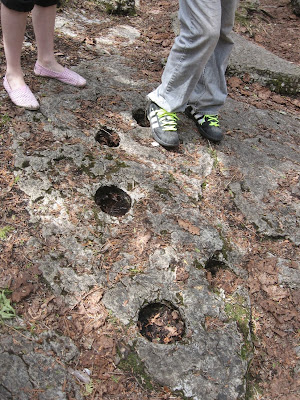The story of the Warsaw Caves in Peterborough County begins about 350 million years ago when the limestone comprising the terrain was laid down in ancient Paleozoic era seabeds. More recently (in geological terms) tens of thousands of years ago glaciers sculpted the landscape, and their meltwaters flowing from Lake Algonquin to Lake Iroquois (the remnants of which form today's Great Lakes) further shaped the terrain, creating the geological features we see today.
It's not unfair to say that a tiny bit of the glaciers remains with us in the present – even in mid-May there is ice in the caves, and one of them has ice year around.
Playing it safe and inspecting a cave to see if there might be an Ursus spelaeus lurking inside ...
The cedars hang on to every available ledge and crevice for dear life. And do not enter if you are subject to vertigo! Photographs simply can't do justice to the steep gullies and ravines around the caves.
A relic of bygone days – I believe this is a fossil gastropod with the shell seen in lengthwise cross-section. There were also what appeared to be coral fossils embedded in some of the ancient limestone.
Hard stones caught in place and swirling around in the current of the ancient riverbed eventually ate their way through the much softer limestone, forming numerous kettles a.k.a. rockmills.
"Ate their way through" – meaning literally, not just as a figure of speech.
The high point of the day, so to speak – a view of the nearby Indian River.
Or perhaps this was the high point, in any event a real treat to find! According to the Peterson Field Guide to Ferns the Walking Fern (Asplenium rhizophyllum) is rare and local and I never thought I would ever see one. There were large patches growing on the thin soil covering the limestone boulders along the Kettle Trail.
The underside of the frond. Yes, this plant is indeed a fern, a flowering plant would not have sori on the underside of its leaves.
When the tips of the fronds encounter suitable growing conditions they sprout plantlets, hence the name "Walking Fern". Incidentally, I found that frond tip already exposed and it was not uprooted just to take a photo. Flora and fauna that are rare are uncommon for a good reason and it's best to let them be and not to disturb them. – "A walking fern may have taken up to five centuries to adapt to that particular rock. Its roots extend into all the little pockets in the rock, modifying the soil beneath the moss. No other fern creates a symbiotic relationship like this.".
Although I didn't know it until the following day I did inadvertently bring home a souvenier from the Warsaw Caves, a Wood Tick (Dermacentor variabilis) hitched a ride in the rolled up sleeve of my shirt. I'm not writing this to scare people away from the great outdoors – I wasn't bitten and this species doesn't carry Lyme Disease, unlike the Black-legged Tick (Ixodes scapularis) that I picked up much closer to home. But be tick-smart: always check yourself and your pets over carefully, and shower and wash clothing after visiting places that might be frequented by ticks. Happy hiking!





















